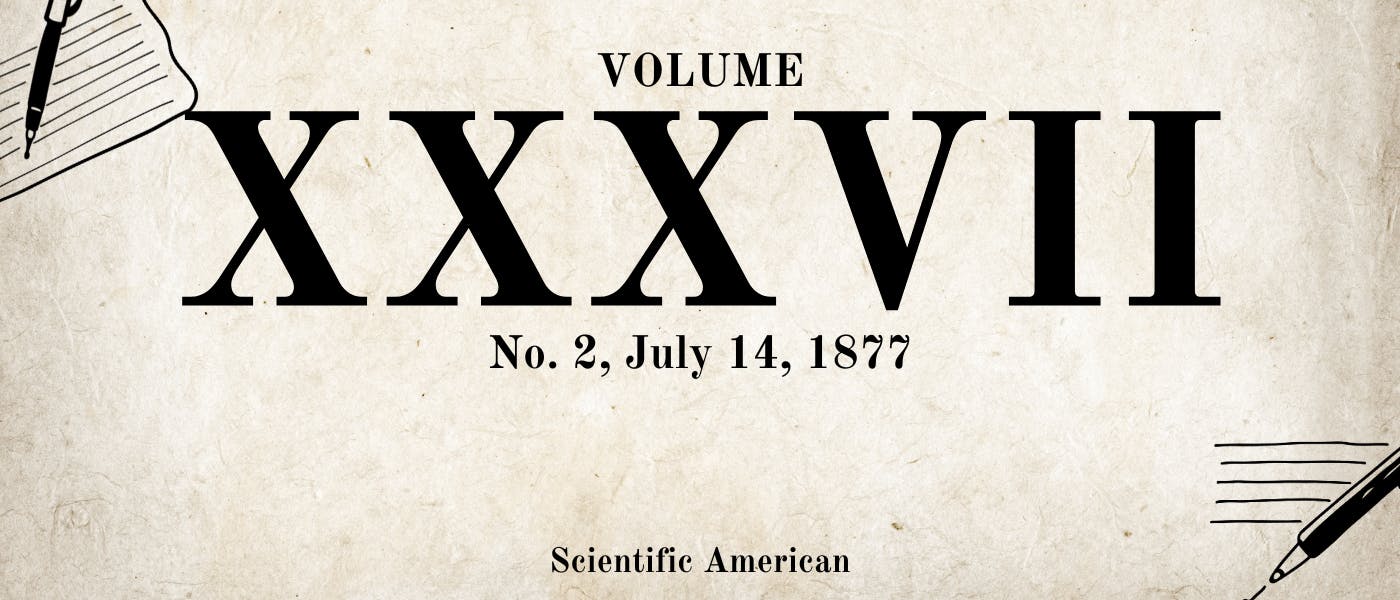Scientific American, Vol. XXXVII.—No. 2. [New Series.], July 14, 1877 by Various, is part of the HackerNoon Books Series. You can jump to any chapter in this book here. Sebastin—An Improved Explosive.
Sebastin—An Improved Explosive.
In the manufacture of the explosive known as dynamite, an infusorial earth is used, which is filled with or made to absorb nitroglycerin. As compared with certain kinds of charcoal, however, the absorptive and retentive power of infusorial earth in small changes of temperature unfavorably affect the common dynamite, and cause a separation of the nitrogylcerin from the infusorial earth. The improvement we now refer to is the invention of G. Fahnehjelm, of Stockholm, Sweden, and consists in the substitution of a highly porous and absorptive species of wood charcoal, in place of the earth heretofore employed. The author designates his production as "sebastin," and gives a number of interesting particulars as follow:
In order to produce a charcoal having the required quantities, the carbonization or coking must be done in such a manner as to completely destroy the organic substances, and to produce as porous a charcoal as possible. For this he selects by preference young trees or striplings or branches of poplar, hazelwood, or alder tree, and he burns them in an open fire. When the wood has been consumed he does not put out the fire by means of water, but leaves it to go out of itself. In this way he obtains a very inflammable and very porous charcoal, which can absorb more than five, and approaching six times its weight of nitroglycerin without any risk of the separation of the oil. The charcoal is pulverized in a wooden mortar, but it should not be reduced to too fine a powder, else it will not so completely absorb the nitroglycerin. The charcoal produced in the ordinary way, or by closed fire, is quite different as regards absorbing power. Charcoal of fir trees may, however, be used, and may acquire nearly the same qualities, that is, if charred a second time in a special oven.
By mixing the different kinds of charcoal, a material may be obtained possessing the required absorbing qualities, and an explosive compound may then be obtained of the required power without loss of the necessary consistency—that is, without being too dry, which is not desirable. The charcoal not only serves as the best absorbent for the nitroglycerin, but it plays also an important part in the combustion. The nitroglycerin in exploding decomposes into steam, carbonic acid, nitrogen, and oxygen. In the explosion of dynamite with inert base the oxygen goes away without being utilized, but in the explosion of this new compound (the new sebastin as he calls it) a part of the absorbent charcoal is burnt by means of the liberated oxygen. The quantity of gas is thus augmented, and also the development of heat, whereby again the tension of this gas is augmented. As, however, the quantity of charcoal necessary for the complete absorption of the nitroglycerin is in all cases much larger than that which can reduce the excess of oxygen produced at the explosion into carbonic acid, he adds to the compound a salt, which also by the combustion gives an excess amount of oxygen which may contribute to burn the rest of the charcoal. For this purpose he uses by preference nitrate of potassa, which may be added without any risk, and which gives the explosive compound a very much greater rapidity or vehemence, and consequent force of explosion.
The composition of the new sebastin depends upon the objects for which it is to be used, and the effects intended to be produced. The strongest compound, and even in this there is stated to be no risk of the separation of the nitroglycerin, is composed of 78 parts by weight of nitroglycerin, 14 of the wood charcoal, and 8 of nitrate of potassa; and when less power is required the proportions are varied, the second quality consisting of 68 per cent. by weight of nitroglycerin, 20 of the charcoal, and 12 of nitrate of potassa.
To show the relative strength of the compounds, the inventor says: Let the dynamic force of pure nitroglycerin be represented by the number 2,884,043.6, then the dynamic force of the sebastin No. 1, as above, will be indicated by 2,416,575, and of the sebastin No. 2 by 1,933,079.4, while that of dynamite No. 1 (consisting of 75 per cent. of nitroglycerin and 25 per cent. of infusorial earth) will be represented by 674,694.
For the above qualities of sebastin the increased effect produced by the greater rapidity of the explosion must be taken into account also. The increase has not yet been measured, but is estimated at 10 per cent. The sebastin may also be compounded in other proportions of the constituent parts, but the object being to produce explosive compounds of the greatest force which it is possible to employ without danger, he merely mentions that the proportion by weight may vary from 50 to 80 per cent. of nitroglycerin, 15 to 35 per cent. of the prepared charcoal, and 5 to 20 per cent. of the nitrate of potassa; the parts being taken by weight, as above stated.
About HackerNoon Book Series: We bring you the most important technical, scientific, and insightful public domain books.
This book is part of the public domain. Various (2012). Scientific American, Vol. XXXVII. —No. 2. [New Series.], July 14, 1877. Urbana, Illinois: Project Gutenberg. Retrieved https://www.gutenberg.org/cache/epub/38481/pg38481-images.html
This eBook is for the use of anyone anywhere at no cost and with almost no restrictions whatsoever. You may copy it, give it away or re-use it under the terms of the Project Gutenberg License included with this eBook or online at www.gutenberg.org, located at https://www.gutenberg.org/policy/license.html.

